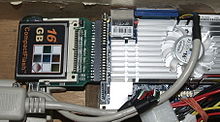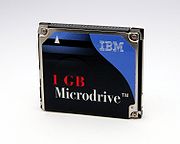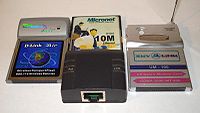- CompactFlash
-
CompactFlash 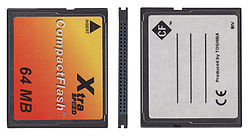
A 64 MiB CompactFlash Type I cardMedia type Mass storage device format Encoding Various file systems Capacity 2 MB to 128 GB[1][2] (CF5.0: up to 128 PB) Developed by SanDisk Dimensions 43×36×3.3 mm (Type I) 43×36×5 mm (Type II) Weight 10 gram (typical) Usage Digital cameras and other mass storage devices Extended from PCMCIA / PC Card CompactFlash (CF) is a mass storage device format used in portable electronic devices. Most CompactFlash devices contain flash memory in a standardized enclosure. The format was first specified and produced by SanDisk in 1994.[3] The physical format is now used for a variety of devices.
CompactFlash became the most successful of the early memory card formats, surpassing Miniature Card, SmartMedia, and PC Card Type I in popularity. Subsequent formats, such as SD/MMC, various Memory Stick formats, and xD-Picture Card offered stiff competition. Most of these cards are smaller than CompactFlash while offering comparable capacity and speed. Proprietary memory card formats for use in professional audio and video, such as P2 and SxS, are physically larger, faster, and costlier.
CompactFlash remains popular and is even supported in some new devices. For example, in 2008, Sony chose CompactFlash as the recording medium for the HVR-MRC1K tapeless video recorder over smaller MemoryStick cards or expensive SxS cards.[4] In 2010, Canon chose CompactFlash as the recording medium for its new professional high-definition video cameras,[5] and Ikegami devices record digital video onto CompactFlash cards through an adaptor.[6]
In November 2010, Sandisk, Sony and Nikon proposed a next generation card format targeted at high-definition camcorders and high-resolution digital photo cameras; not backward compatible, the proposed format would come in a similar form factor as CF/CFast but be based on SATA[7] instead of ATA and would offer read speed of 500 Mbyte/s and storage capabilities beyond 2 TiB.[8] It remains unclear whether the CFA will adopt this proposal, as CF 5.0 already supports media up to 128 PiB and CF 6.0 adds speeds up to 167 Mbyte/s, while the SATA-based CFast already defines speeds up to 300 Mbyte/s.
Description
There are two main subdivisions of CF cards, Type I (3.3 mm thick) and the thicker Type II (CF2) cards (5 mm thick). The CF Type II slot is used by Microdrives and some other devices, such as the Hasselblad CFV Digital Back for the Hasselblad series of medium format cameras. There are four main speeds of cards including the original CF, CF High Speed (using CF+/CF2.0), a faster CF 3.0 standard and a yet faster CF 4.0 standard that is being adopted as of 2007. The thickness of the CF card type is dictated by the preceding PC Card standard.
CompactFlash was originally built around Intel's NOR-based flash memory, but has switched to NAND technology.[9] CF is among the oldest and most successful formats, and has held a niche in the professional camera market especially well. It has benefited from both a better cost to memory-size ratio than other formats, (for much of its life) and generally from greater available capacity than other formats.
CF cards can be used directly in a PC Card slot with a plug adapter, used as an ATA (IDE) or PCMCIA storage device with a passive adapter or with a reader, or attached to other types of ports such as USB or FireWire. As some newer card types are smaller, they can be used directly in a CF card slot with an adapter. Formats that can be used this way include SD/MMC, Memory Stick Duo, xD-Picture Card in a Type I slot, and SmartMedia in a Type II slot, as of 2005. Some multi-card readers use CF for I/O as well.
Technical details
CompactFlash interface is a 50 pin subset of the 68 pin PCMCIA[10] connector. "It can be easily slipped into a passive 68-pin PCMCIA Type II to CF Type I adapter that fully meets PCMCIA electrical and mechanical interface specifications."[11] The Compactflash interface operates, depending on the state of a mode pin on powerup, as either 16-bit PC Card (0x7FF address limit) or as an IDE (PATA) interface.[12]
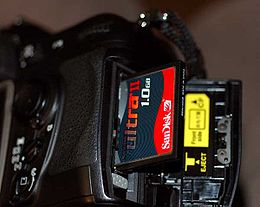 1 GB CF card in a Nikon D200 DSLR camera
1 GB CF card in a Nikon D200 DSLR camera
CompactFlash IDE mode defines an interface that is smaller than, but electrically identical to, the ATA interface. That is, it appears to the host device as if it were a hard disk. The CF device contains an ATA controller. CF devices operate at 3.3 volts or 5 volts, and can be swapped from system to system. CompactFlash supports C-H-S and 28-bit Logical block addressing (CF 5.0 introduced support for LBA-48). CF cards may be set to master or slave, but have issues sharing the IDE bus. CF cards with flash memory are able to cope with extremely rapid changes in temperature. Industrial versions of flash memory cards can operate at a range of −45 to +85 °C.
NOR-based flash has lower density than newer NAND-based systems, and CompactFlash is therefore the physically largest of the three memory card formats introduced in the early 1990s, being derived from the JEIDA/PCMCIA Memory Card formats. The other two are Miniature Card (MiniCard) and SmartMedia (SSFDC). However, CF did switch to NAND type memory later. The IBM Microdrive format implements the CF Type II interface, but is not solid-state memory. Hitachi and Seagate also make microdrives.
Speed
CompactFlash IDE (ATA) emulation speed is usually specified in "x" ratings, e.g. 8x, 20x, 133x. This is the same system used for CD-ROMs and indicates the maximum transfer rate in the form of a multiplier based on the original audio CD data transfer rate, which is 150 kbyte/s.
 , kbyte/s
, kbyte/s
where R = transfer rate, K = speed rating. For example, 133x rating means transfer speed of: 133 * 150 kbyte/s = 19,950 kbyte/s ~ 20 Mbyte/s.
These are manufacturer speed ratings. Actual transfer speed may be higher, or lower, than shown on the card[13] depending on several factors.
Solid state
For reads, the onboard controller first powers up the memory chips from standby. Reads are usually in parallel, error correction is done on the data, then transferred through the interface 16 bits at a time. Error checking is required due to soft read errors. Writes require powerup from standby, wear leveling calculation, a block erase of the area to be written to, ECC calculation, write itself (an individual memory cell read takes around 100 ns, a write to the chip takes 1ms+ or 10,000 times longer).
Because the USB 2.0 interface is limited to 60 Mbyte/s and lacks bus mastering hardware, USB implementation results in slower access.
A direct motherboard connection is often limited to 33 Mbyte/s because IDE to CF adapters lack high speed ATA (66 Mbyte/s plus) cable support. Power on from sleep/off takes longer than power up from standby.
Magnetic media
Many 1-inch (25 mm) hard drives (often referred to by the trademarked name "Microdrive") typically spin at 3600 rpm so rotational latency is a consideration, as is spin-up from standby or idle. Seagate's 8 GB ST68022CF drive[14] spins up fully within a few revolutions but power draw can reach up to 350 milliamps and runs at 40-50 mA average power. Its average seek time is 8 ms and can sustain 9 Mbyte/s read and write, and has an interface speed of 33 Mbyte/s. Hitachi's 4 GB Microdrive is 12 ms seek, sustained 6 Mbyte/s.
Capacities and compatibility
- Since flash memory is generally produced in capacities that are multiples of powers of 2, IEC standard binary prefixes are used throughout this article.
The CF Specification (support 28 bit LBA) can support capacities up to 137 GB (128 GiB). Prior to 2006, CF drives using on magnetic media offered the highest capacities. But with the advent of 16 GiB and higher solid-state CF cards, they have offered the higher capacities.
Though, as of 2011, solid-state drives (SSDs) had supplanted both kinds of CF drives for large capacity requirements. Consequently, commercially available solid-state CF cards rarely go above 64 GiB, and 1-inch hard drives generally top out at 8 GiB.
Solid state capacities
SanDisk announced its 16 GiB Extreme III card at the Photokina trade fair, in September, 2006.[15] That same month, Samsung announced 16, 32 and 64 GiB CF cards.[16] Two years later, in September, 2008, PRETEC announced 100GB cards.[17]
Magnetic media capacities
Seagate announced a 5 GiB "1-inch hard drive" in June, 2004,[18] and an 8 GiB version in June, 2005.[19]
Use in place of a hard disk drive
In early 2008 the CFA demonstrated CompactFlash cards with a built in SATA interface.[20] Several companies make adapters to allow CF cards to be connected to PCI, IDE, 44-pin laptop mini-IDE, and SATA connections,[21] allowing a CF card to act as a solid-state drive with virtually any operating system or BIOS, and even in a RAID configuration.
Reliability
Original PC Card memory cards used an internal battery to maintain data when power was removed; the rated life of the battery was the only reliability issue. CompactFlash cards that use flash memory, like other flash-memory devices, are rated for a limited number of erase/write cycles for any "block." (Read cycles do not cause wear to the device.) Cards using NOR flash had a write endurance of 10,000 cycles. Current cards using NAND flash are rated for 1,000,000 writes per block before hard failure.[22] This is less reliable than magnetic media.[23] Car PC Hacks[24] suggests disabling the Windows swap file and using its Enhanced Write Filter (EWF) to eliminate unnecessary writes to flash memory.[25] Additionally, when formatting a flash-memory drive, the Quick Format method should be used, as one need not write every block on the drive, as may be necessary for a new magnetic disk.
Most CompactFlash flash-memory devices limit wear on blocks by varying the physical location to which a block is written. This process is called wear leveling. When using CompactFlash in ATA mode to take the place of the hard disk drive, wear leveling becomes critical because low-numbered blocks contain tables whose contents change frequently. Current CompactFlash cards spread the wear-leveling across the entire drive. The more advanced CompactFlash cards will move data that rarely changes to ensure all blocks wear evenly.
NAND flash memory is prone to frequent soft read errors.[24] The CompactFlash card includes error checking and correcting (ECC) that detects the error and re-reads the block. The process is transparent to the user, although it may slow data access.
As flash memory devices are solid-state, they are more shock-proof than rotating disks. For example, the ST68022CF Microdrive is shock rated at 175G operating and 750G non-operating.
The possibility for electrical damage from upside-down insertion is prevented by asymmetrical side slots, assuming that the host device uses a suitable connector.
Small cards consume around 5% of the power required by small disk drives and still have reasonable transfer rates of over 45 Mbyte/s for the more expensive 'high-speed' cards.[26] However, the manufacturer's warning on the flash memory used for ReadyBoost indicates a current draw in excess of 500 mA.
File systems
Originally, flash memory used Flash File System and JFFS to work around low-level technical issues. Hardware now hides much of the complexity from the end user, and CompactFlash cards for use in consumer devices are typically formatted as FAT12 (for media up to 16 MiB), FAT16 (for media up to 2 GiB, sometimes up to 4 GiB) and FAT32 (for media larger than 2 GiB). This lets the devices be read by personal computers but also suits the limited processing ability of some consumer devices such as cameras.
There are varying levels of compatibility among FAT32-compatible cameras, MP3 players, PDAs, and other devices. While any device that claims FAT32-capability should read and write to a FAT32-formatted card without problems, some devices are tripped up by cards larger than 2 GB that are completely unformatted, while others may take longer to apply a FAT32 format.
The way many digital cameras update the file system as they write to the card creates a FAT32 bottleneck. Writing to a FAT32-formatted card generally takes a little longer than writing to a FAT16-formatted card with similar performance capabilities. For instance, the Canon EOS 10D writes the same photo to a FAT16-formatted 2 GB CompactFlash card somewhat faster than to a same speed 4 GB FAT32-formatted CompactFlash card, although the memory chips in both cards have the same write speed specification.[27] Although FAT16 is more wasteful of disk space with its larger clusters, it works better with the write strategy that flash memory chips require.
The cards themselves can of course be formatted with any type of file system such as JFS and NTFS. It can be divided into partitions as long as the host device can read them. CompactFlash cards are often used instead of hard drives in embedded systems, dumb terminals and various small form-factor PCs that are built for low noise output or power consumption. CompactFlash cards are often more readily available and smaller than purpose-built solid-state drives and often have faster seek times than hard drives.
CF+ and Compact Flash specification revisions
When CompactFlash was first being standardized, even full-sized hard disks were rarely larger than 4 GB in size, and so the limitations of the ATA standard were considered acceptable. However, CF cards manufactured after the original Revision 1.0 specification are available in capacities up to 128 GiB. While the current revision 6.0 works in [P]ATA mode, future revisions are expected to implement SATA mode.
- CompactFlash Revision 1.0 (1995), 8.3 Mbyte/s (PIO mode 2), support for up to 128 GiB (137 GB) storage space.
- CompactFlash+ aka CompactFlash I/O (1997)
- CF+ and CompactFlash Revision 2.0 (2003) added an increase in speed to 16.6 Mbyte/s data-transfer (PIO mode 4). At the end of 2003, DMA 33 transfers were added as well, available since mid 2004.
- CF+ and CompactFlash Revision 3.0 (2004) added support for up to a 66 Mbyte/s data transfer rate (UDMA 66), 25 Mbyte/s in PC Card mode, added password protection, along with a number of other features. CFA recommends usage of the FAT32 filesystem for storage cards larger than 2 GiB.
- CF+ and CompactFlash Revision 4.0 (2006) added support for IDE Ultra DMA Mode 6 for a maximum data transfer rate of 133 Mbyte/s (UDMA 133).
- CF+ and CompactFlash Revision 4.1 (2007) added support for Power Enhanced CF Storage Cards.
- CompactFlash Revision 5.0 (2010) added a number of features, including 48-bit addressing (supporting 128 Petabyte of storage), larger block transfers of up to 32 Megabytes, quality-of-service and video performance guarantees, and other enhancements [28]
- CompactFlash Revision 6.0 (November 2010) added UltraDMA Mode 7 (167 Mbyte/s), ATA-8/ACS-2 sanitize command, TRIM and an optional card capability to report the operating temperature range of the card.[29]
CE-ATA
Main article: CE-ATACE-ATA is a Serial ATA interface based on the MultiMediaCard standard.[30][31]
CFast
A variant of CompactFlash known as CFast is based on the Serial ATA bus, rather than the Parallel ATA/IDE bus for which all previous versions of CompactFlash are designed.
CFast supports a higher maximum transfer rate than current CompactFlash cards. As of 2011[update], SATA supports transfer rates up to 600 Mbyte/s while PATA is limited to 133 Mbyte/s using UDMA 6.
CFast cards are not physically or electrically compatible with CompactFlash cards. However, since SATA can emulate the PATA command protocol, existing CompactFlash software drivers can be used, although writing new drivers to use AHCI instead of PATA emulation will almost always result in significant performance gains. CFast cards use a 7-pin SATA data connector (identical to the standard SATA connector), but a 17-pin power connector that appears incompatible with the standard 15-pin SATA power connector,[32] so an adaptor is required to connect CFast cards in place of standard SATA hard drives.
The first CFast cards reached the market in late 2009.[33] At CES 2009, Pretec showed a 32 GB CFast and announced that they should reach the market within a few months.[34] Delock began distributing CFast cards in 2010 and offers several card readers with USB3.0 port and eSATAp (power over eSATA) port to support CFast cards.
Type I and Type II
The only physical difference between the two types is that Type I devices are 3.3 mm thick while Type II devices are 5 mm thick.[35] Electrically, the two interfaces are the same except that Type I devices are permitted to draw up to 70 mA supply current from the interface, while type II devices may draw up to 500 mA.
The vast majority of all Type II devices are Microdrives and other miniature hard drives. Flash based Type II devices are rare but a few examples do exist. Compact Flash — Secure Digital adapters usually are Type II.[36][37] Even the largest capacity cards commonly available are Type I cards. Most card readers will read both formats, with the exception of some early CF based cameras or poorer quality USB card readers where the slot is too small. Various manufacturers of 4 GB Compact Flash cards such as Sandisk, Toshiba, Alcotek and Hynix have developed devices that support mainly type I slots. Some of the latest DSLRs, like the Nikon D700, have also dropped Type II support.[38]
Microdrives
Main article: MicrodriveMicrodrives are tiny hard disks—about 25 mm (1 inch) wide—packaged with a CompactFlash Type II form factor and interface. They were developed and released in 1999 by IBM with a capacity of 170 Mbyte. IBM sold its disk drive division, including the Microdrive trademark, to Hitachi in December 2002. There are now other brands of Microdrives (such as Seagate, Sony, etc.), and, over the years, these have become available in increasing capacities (up to 8 GB as of late 2008).
While these drives fit into and work in any CF II slot, the early versions drew more current (500 mA maximum) than flash memory (100 mA maximum). However current Microdrives use less than 200 mA for reads and writes (300 mA peak), and some flash devices used for high speed data e.g. Readyboost (memory can't power down to standby) draw more than the USB standard allows (500 mA). As they are mechanical devices, Microdrives are susceptible to damage from physical shock or temperature changes. However, Microdrives are not subject to the write cycle limitation inherent to flash memory.
The iPod mini, Nokia N91, iriver H10 (5 or 6 GB model), PalmOne LifeDrive, and Rio Carbon all used a CF Microdrive to store data.
Compared to other portable storage
- CompactFlash cards that use flash memory are more rugged than some competing solutions because they are solid-state. (See also Reliability above.) Separately, CompactFlash cards are thicker than other card formats, which may render them less susceptible to breakage from harsh treatment.
- As CompactFlash cards support the IDE/ATA command protocol with the host device, they are the removable memory medium most often used as the hard disk drive of a personal computer. (See above.)
- CompactFlash does not have any built in DRM or cryptographic features found on some USB flash drives and other card formats. The lack of such features contributes to the openness of the standard, since card standards with such features are subject to restrictive licensing agreements.[citation needed]
- The initial CompactFlash specification envisaged a higher maximum capacity than other card formats. For this reason, many early CompactFlash host devices are usable with modern multi-gigabyte memories, where users of other families such as SecureDigital have had to migrate to SDHC and SDXC.
- CompactFlash lacks the mechanical write protection switch that some other devices have, as seen in a comparison of memory cards.
- CompactFlash is physically larger than other card formats. This limits its use, especially in miniature consumer devices where internal space is limited, such as point-and-shoot digital cameras. (An offsetting benefit of larger size is that the card is easier to insert and remove, and harder to misplace.)
Counterfeiting
The marketplace for CompactFlash is extensive and includes counterfeits. Off-brand or counterfeit cards may be mislabeled, might not contain the actual amount of memory their controllers report to the host device, and may use types of memory that are not rated for the number of erase/rewrite cycles that the purchaser expects.[39][40]
Other devices in the CF form factor
Since CompactFlash interface is electrically identical to the 16-bit PC card, the CompactFlash form factor is also used for a variety of Input/Output and interface devices; many standard PC cards have CF counterparts, some examples include:
- Ethernet
- Bluetooth
- Modem and GSM Modem, including GPRS and EDGE
- Wi-Fi
- Digital Camera
- GPS
- Barcode scanner
- RFID
- Magnetic stripe reader
- Super VGA display adapter
- Serial port and USB 1.1 host adapters
- readers for various other Flash media
CompactFlash card manufacturers
- A-DATA
- ATP
- Alcotek
- Apacer
- Cactus-tech
- Canon
- e c o SolidStateDrive Corporation
- FujiFilm
- Hitachi Maxell
- Kingston Technology
- Kodak
- Lexar
- Memorex
- Olympus
- Panasonic
- PNY
- PQI
- Ritek
- SanDisk
- Samsung
- Silicon Power
- Sony
- Swissbit
- Toshiba
- Transcend
- TwinMOS
- Verbatim Corporation
- UMAX
See also
- Comparison of memory cards
- Microdrive
- PC Card
- ExpressCard
- Random access memory
References
- ^ http://www.compactflash.org/pr/030302b.pdf
- ^ CompactFlash Frequently Asked Questions
- ^ Digiprint Uk
- ^ HVRMRC1K Memory Recording Unit
- ^ File-based video recording onto CF cards: features and benefits, by Canon Inc.
- ^ Ikegami at Government Video EXPO 2010, press-release by Ikegami Ltd.
- ^ http://www.hsc-us.com/pdf/Evolution_of_cf_whitepaper.pdf
- ^ http://www.engadget.com/2010/11/30/sandisk-sony-and-nikon-propose-500mb-per-second-memory-card-wi/
- ^ http://www.karlfoster.com/text/DP_flashmemory.doc
- ^ http://www.pcmcia.org/pccard.htm
- ^ http://www.compactflash.org/faqs/faq.php
- ^ http://www.allpinouts.org/index.php/CompactFlash
- ^ http://photofocus.com/2009/06/30/long-term-test-udma-flash-memory-lexar-won/
- ^ http://www.seagate.com/ww/v/index.jsp?name=ST1.2-Series_8-GB_CompactFlash_ST68022CF&vgnextoid=5ddc44ab7cffd010VgnVCM100000dd04090aRCRD&locale=en-US#tTabContentSpecifications
- ^ SanDisk Introduces the World's Highest Capacity Card for Professional Photographers
- ^ Samsung Announces First 40-nanometer Device 32 Gb NAND Flash with Revolutionary Charge Trap Technology
- ^ Pretec Releases 64GB and 100GB CF Card - Highest Capacity in the World
- ^ Seagate Expands Consumer Electronics Leadership with First 5GB 1-Inch Hard Drive, First 5GB Compact Flash Hard Drive, and New 400GB DVR Hard Drive
- ^ Seagate Does it Again: Drives Innovation with 10 New, Groundbreaking Hard Disc Drives
- ^ Submerged camera holds functional memory card two years after accident - Engadget
- ^ "Compact Flash and Secure Digital Adapters". Addonics. http://www.addonics.com/products/cf_adapter/. Retrieved 2008-05-18.
- ^ http://www.samsung.com/global/business/semiconductor/products/flash/downloads/applicationnote/app_nand.pdf
- ^ The comparison is not in the same terms as for magnetic media, for which hours of operation and reads also impose wear.
- ^ a b Car PC hacks, Damien Stolarz, 2005, Farnham:O’Reilly Media, Sebastopol, CA, USA, ISBN 0596008716
- ^ EWF is available only in XP Embedded, not the XP Professional, Home, or Media Editions versions of Windows.
- ^ SanDisk Extreme IV review
- ^ Rob Galbraith CompactFlash Performance Database
- ^ CFA Announces Availability of the New CF5.0 Specification
- ^ CompactFlash 6.0
- ^ http://www.hitachigst.com/tech/techlib.nsf/techdocs/98ABCD658D41637A8625706700616161/$file/Ready_for_CE-ATA.pdf
- ^ http://www.mmca.org/tech/MMCA_System_summaryV41.pdf
- ^ "CFast – Evolution of the CompactFlash Interface" (PDF). CompactFlash Association. 2008-04-14. http://www.hsc-us.com/pdf/Evolution_of_cf_whitepaper.pdf. Retrieved 2010-01-22.
- ^ Donald Melanson (2008-02-25). "CFast CompactFlash cards now said to be coming in "18 to 24 months"". Engadget. http://www.engadget.com/2008/02/25/cfast-compactflash-cards-now-said-to-be-coming-in-18-to-24-mont/.
- ^ "Pretec release CFast card with SATA interface". DPReview. 2008-01-08. http://www.dpreview.com/news/0901/09010902preteccfaststoragecards.asp.
- ^ CompactFlash Frequently Asked Questions
- ^ Delkin Devices ship 224MB CF type II: Digital Photography Review
- ^ Lexar Media announces 8 GB CompactFlash type II
- ^ Nikon D700 - see Tech Specs
- ^ eBay.ie Guides - FAKE SanDisk Extreme Compact Flash Cards Exposed
- ^ July 2007 - Counterfeit SanDisk Cards
External links
- CompactFlash Association
- Rob Galbraith DPI: CF Performance Database
- CompactFlash connector description and pin layout
- CompactFlash pinout
- CompactFlash Connector Schematic and complete Pinout
Memory cards Main articles Memory card reader • Comparison of memory cards • SD Card and MultiMediaCard family comparison
Types CompactFlash (CF) • Express Card • JEIDA • MultiMediaCard (MMC) • Memory Stick (MS/MS-PRO) • miCard • Microdrive (MD) • MiniCard • P2 • PC Card (PCMCIA, CardBus, CardBay) • Secure Digital (SD) • SmartMedia (SM) • SxS • Universal Flash Storage (UFS) • USB • xD-PictureCategories:- Computer memory
- Solid-state computer storage media
Wikimedia Foundation. 2010.

